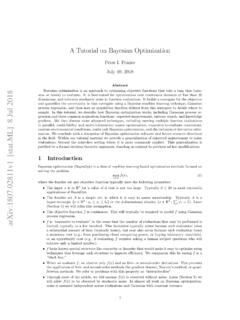Transcription of Duality for Mixed-Integer Linear Programs
1 Duality for Mixed-Integer Linear ProgramsM. Guzelsoy T. K. Ralphs Original May, 2006 Revised April, 2007 AbstractThe theory of Duality for Linear Programs is well-developed and has been successful in advancing boththe theory and practice of Linear programming. In principle, much of this broad framework can be ex-tended to Mixed-Integer Linear Programs , but this has proven difficult, in part because Duality theory doesnot integrate well with current computational practice. This paper surveys what is known about dualityfor integer Programs and offers some minor extensions, with an eye towards developing a more : Duality , Mixed-Integer Linear Programming, Value Function, Branch and IntroductionDuality has long been a central tool in the development of both optimization theory and methodology.
2 Thestudy of Duality has led to efficient procedures for computing bounds, is central to our ability to perform postfacto solution analysis, is the basis for procedures such as column generation and reduced cost fixing, and hasyielded optimality conditions that can be used as the basis for warm starting techniques. Such proceduresare useful both in cases where the input data are subject to fluctuation after the solution procedure has beeninitiated and in applications for which the solution of a series of closely-related instances is required. This isthe case for a variety of integer optimization algorithms, including decomposition algorithms, parametric andstochastic programming algorithms, multi-objective optimization algorithms, and algorithms for analyzinginfeasible mathematical theory of Duality for Linear Programs (LPs) is well-developed and has been extremely successful incontributing to both theory and practice.
3 By taking advantage of our knowledge of LP Duality , it has been Department of Industrial and Systems Engineering, Lehigh University, Bethlehem, PA menal Department of Industrial and Systems Engineering, Lehigh University, Bethlehem, PA tkr21possible to develop not only direct solution algorithms for solving LPs but also sophisticated dynamic meth-ods appropriate for large-scale instances. In theory, much of this broad framework can be extended tomixed-integer Linear Programs (MILPs), but this has proven largely impractical because a Duality theorywell-integrated with practice has yet to be developed. Not surprisingly, it is difficult to develop a standarddual problem for MILP with properties similar to those observed in the LP case.
4 Such dual problems aregenerally either not strong or not computationally tractable. Unlike the LP case, dual information is noteasy to extract from the most commonly employed primal solution algorithms. In Section , we discussthe challenges involved in extracting dual information in the case of branch and cut, which is the mostcommonly employed solution algorithm for MILPs study of Duality for MILPs can be considered to have two main goals: (1) to develop methods forderivinga priorilower bounds on the optimal solution value of a specific MILP instance and (2) to developmethods for determining the effect of modifications to the input data on the optimal solution and/or optimalsolution valuepost facto. Methods for producing a priori lower bounds are useful primarily as a meansof solving the original problem, usually by embedding the bounding procedure into a branch-and-boundalgorithm.
5 Such bounding methods have received a great deal of attention in the literature and are well-studied. Methods for producing dual information post facto, on the other hand, are useful for performingsensitivity analyses and for warm starting solution procedures. Such methods have received relatively littleattention in the literature. In both cases, the goal is to produce dual information. Methods of the secondtype, however, can take advantage of information produced as a by-product of a primal solution primary goal of this study is to survey previous work on methods of the second type with an eye to-wards developing a framework for MILP Duality that can be integrated with modern computational methods have evolved significantly since most of the work on integer programming dualitywas done and a close reexamination of this early work is needed.
6 We have attempted to make the paper asgeneral and self-contained as possible by extending known results from the pure integer to the mixed -integercase whenever possible. We have included proofs for as many results as space would allow, concentratingspecifically on results whose proofs were not easily accessible or for which we provide a generalization oralternative approach. The proofs for all results not included here can be found in the references cited. Thissurvey draws heavily on the foundational work of a small cadr e of authors who contributed greatly to thestudy of MILP Duality , including Gomory, Johnson, Wolsey, Blair, and Jeroslow, and is in many respects anupdating and expansion of the excellent papers of Wolsey [1981] and Williams [1996].
7 Definitions and NotationBefore beginning, we briefly introduce some terminology and notation. Alinear programis the problem ofminimizing a Linear objective function over a polyhedral feasible regionP={x Rn+|Ax=b}(1)defined by rational constraint matrixA Qm nand right-hand side vectorb Rm. Amixed-integerlinear programis an LP with the additional constraint that a specified subset of the variables must take on2integer values. For the remainder of the paper, we address the canonical MILP instance specified by theconstraints in (1), with theinteger variables(those required to take on integer values) indexed by the setI={1, .. , r} N={1, .. , n}ifr >0(otherwise,I= ). The remaining variables, indexed by the setC=N\I, constitute thecontinuous variables.
8 The feasible region is then given byS=P (Zr Rn r)and the MILP instance can be stated as that of determiningzIP= minx Scx(2)forc Rn. The rationality of the constraint matrixAis required to ensure the consistency of (2) and guar-antees that any such program is either infeasible, unbounded or has a finite optimal value (Meyer [1974]).In the sequel, we refer to this canonical instance of MILP as theprimal a given MILP, we call anyx Safeasible solutionwithsolution valuecxand anyx such thatcx =zIPanoptimal solution. Aside from determining the valuezIP, the goal of solving (2) is to findsuch an optimal solution. The LP obtained from a given MILP by removing the integrality requirements onthe variables, , settingI= , is referred to as the associatedLP relaxation.
9 The associatedpure integerlinear program(PILP), on the other hand, is obtained by requiringallvariables to be integer, , settingr=n. For any index setK N,AKis the submatrix consisting of the corresponding columns ofAandsimilarly,yKis the vector consisting of just the corresponding components of a what follows, we frequently refer to certain classes of functions, defined 1 Let a functionfbe defined over domainV. Thenfis subadditiveiff(v1) +f(v2) f(v1+v2) v1, v2, v1+v2 V. linearifVis closed under addition and scalar multiplication (v1) +f(v2) =f(v1+v2) v1, v2 V, ( v) = f(v) v V, R. convexifVandepi(f) ={(v, y) :v V, y f(v)}are convex sets, and polyhedralifepi(f)is a 2 For a givenk N, let k={f|f:Rk R}, Lk={f k|fis Linear }, Ck={f k|fis convex}, Fk={f k|fis subadditive}.
10 3 The notationd efor a scalar is used to denote the smallest integer greater than or equal to . Similarly,we letb c= d e. For a functionf k,dfeis the function defined bydfe(d) =df(d)e d , thel1norm of a vectorx= (x1, .. , xn)is denoted by x 1= ni=1|xi|. Outline of the PaperThe outline of the paper is as follows. In Section 2, we introduce several notions of MILP Duality that haveappeared in the literature and discuss the relationships between them. In Section 3, we discuss in moredetail the well-knownsubadditive dual, which yields a generalization of many Duality results from linearprogramming, but does not integrate easily with current computational practice. In Section 4, we discussmethods for obtainingdual functionsthat provide a lower bound on the objective function value of MILP instances in the neighborhood of a given base instance and can be seen as solutions to certain dual problemswe present in Sections 2 and 3.












